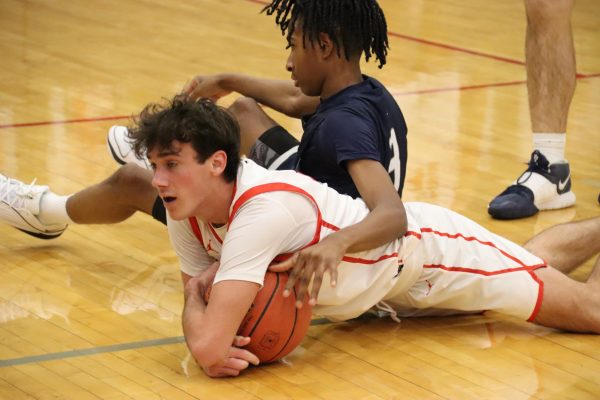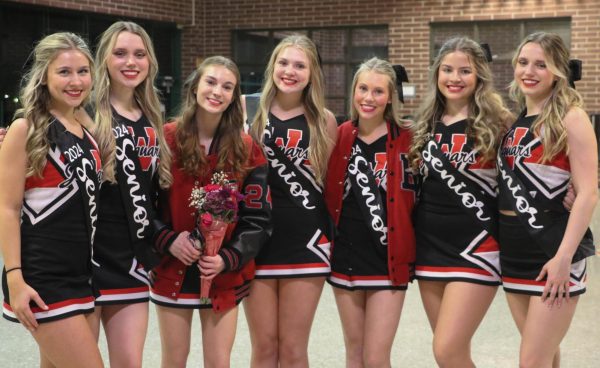The Body Issue
Faculty and students give their opinion on the rise of the body-positivity movement.
Before senior Katie Vanbeber entered high school, she remained unaware of the eating disorders and body-image issues that plague many individuals. However, as the pressures of perfection ensued, she witnessed her friends starve themselves to lose weight.
“As we progressed in high school, a lot of my friends didn’t eat constantly or would go full days without eating, and they all got skinny,” Vanbeber said.
Teenagers face pressure to conform to conventional beauty standards portrayed in the media, developing a damaging relationship with their body as a result. Meanwhile, body-positive activists attempt to destroy body-shaming and the false idea that both boys and girls must conform to the idealized body shape.
From the Renaissance to modern times, people manipulated paintings and pictures to represent the ideal body type of that era. In the 1500s, Hans Holbein allegedly exaggerated the beautiful features of Anne of Cleves, making her more appealing to men. In the 1930s, photographer George Hurrell and retoucher James Sharp spent six hours removing the wrinkles and erasing the spots from the actress Joan Crawford’s face. Cosmo Philippines slimmed the figures of “Riverdale” stars Lili Reinhart and Camila Mendes in 2018.
People continue to perpetuate the myth of perfection through photo-retouching apps like Facetune, which allows users to correct their imperfections. Since its initial release in March 2013, consumers have purchased and downloaded the app over 50 million times. Falsified beauty on social media, aided by photoshopping, and the pressure to conform all lead to strained or disappearing self-confidence.
Teacher Paige Mulvihill, a former club sponsor for REbeL, detailed her concern over the increasing emphasis placed on image. REbeL is a club designed to address eating and body-image concerns.
“There are so many people that struggle with eating disorders and body dysmorphia,” Mulvihill said. “They’re comparing themselves to the airbrushed photos, supermodels and people in photographs, which are unrealistic and it gets to a point where it’s unhealthy.”
People, especially young and susceptible teens, are exposed to unrealistic standards early on. In an informal survey with 174 BV West students, the Spotlight found that 54 percent of teens feel more insecure about their physical appearance after spending time on social media, and 53 percent have, or know someone who suffers from an eating disorder.
“Aside from those physically dangerous iterations of their feelings, there is a general depression and self-hatred that goes along with [body-image issues],” Mulvihill said. “It ruins your life and keeps you from certain opportunities.”
According to a study in the Journal of the American Medical Association, young people exposed to these misleading depictions of beauty are then more likely to seek cosmetic surgery later in life. The study revealed that teens who apply Snapchat filters or regularly use instagram are more likely to undergo cosmetic surgery compared to nonusers.
Young people don’t always hear rhetoric from society or their peers that emphasizes natural beauty and self-confidence. Some students might even encourage insecurities through crude comments.
“People fat-shame girls a lot,” Vanbeber said. “I hear girls being called ‘whales’ and ‘cows.’ That’s only some people, but the majority are nice.”
This rise in photo-editing and low self-confidence among individuals then spurred a new body-positive movement that stems from activists reclaiming social media platforms. Body-positive models received a slew of support for their body-acceptance and appreciation for all sizes. Vanbeber became inspired as well, starting her own website called Love Your Body KC, to raise awareness about body-image issues and eating disorders.
After the body issue gained prevalence, the pioneers of the movement continued to spread the idea of size-inclusivity and self-love. The body-positivity campaign later encouraged new marketing methods in both the clothing and beauty industries. For example, apparel brands like Aerie and Savage X Fenty feature models of different weights and waistlines.
The beauty industry attributes this shift to the Fenty effect, which denotes the breakthrough in product offerings that occurred in September 2017 when Rihanna launched 50 new shades of the Fenty Beauty foundation. The release inspired other companies to create a broader makeup selection for people of color. Both drugstore and high-end brands are now pushing for inclusive marketing, targeting wider audiences with diverse body and skin types.
“I think [brands] are moving in the right direction to be more inclusive,” said Revlon Assistant Brand Manager, Erica Mackenzie. “I think it’s part of the larger trend of inclusivity, and from my marketing perspective, we see that with skin tone ringing ranges.”
The beauty industry is not only emphasizing a broader range of makeup tones, but they are also featuring a diverse group of skin colors and body types in their campaigns. Revlon recently hired plus-size model Ashley Graham, actress Gal Gadot and other body-positive activists for its Live Boldly campaign. The slogan means customers, regardless of size, race and gender, should be confident in every aspect of their lives.
While these campaigns represent an effort in the beauty community to encourage self-love, some people might view it as a money-motivated but still positive marketing technique.
“I’m always pleased when companies are using something like [body-positivity] to market,” Mulvihill said. “For a long time, there weren’t all of these different shades for all these different people. How frustrating to go somewhere looking at a magazine and the colors don’t match you, or nobody looks like you; that feels like people don’t think I’m beautiful.”
Many trends and campaigns attempt to solve the issues people encounter on their journey to body-positivity. Eating disorders and rampant photoshopping experienced pushback from body-positive activists and beauty or fashion brands, all encouraging confidence and self-love instead. However, body-positivity may remain unattainable, at the moment, for many people.
To compensate for the inability to love one’s body, individuals turn to the upcoming body-neutrality movement, which emphasizes the mind and health rather than physical appearance.
“I think that people overthink [body-positivity],” Vanbeber said. “If people said ‘OK, this is my body, and I’m doing my best to keep it healthy,’ then that’s the best they can do.”
Vanbeber wants to normalize all body types and emphasize wellness rather than societal beauty standards. After witnessing the painful effects of social media and impossible body goals, she said she felt that as a school and community, we should work to educate each other and destigmatize body-image issues. According to the Spotlight survey, 81 percent of BV West students agree with Vanbeber and think that the lack of confidence among young guys and girls needs a broader discussion in schools and among peers.
“You’re not alone,” Vanbeber said. “I’ve realized that so many people close to me are either insecure about being too fat or too skinny. They don’t have regular eating patterns or starve themselves. It’s a lot more common than you think, and it’s not too taboo to talk about as people make it seem.”











